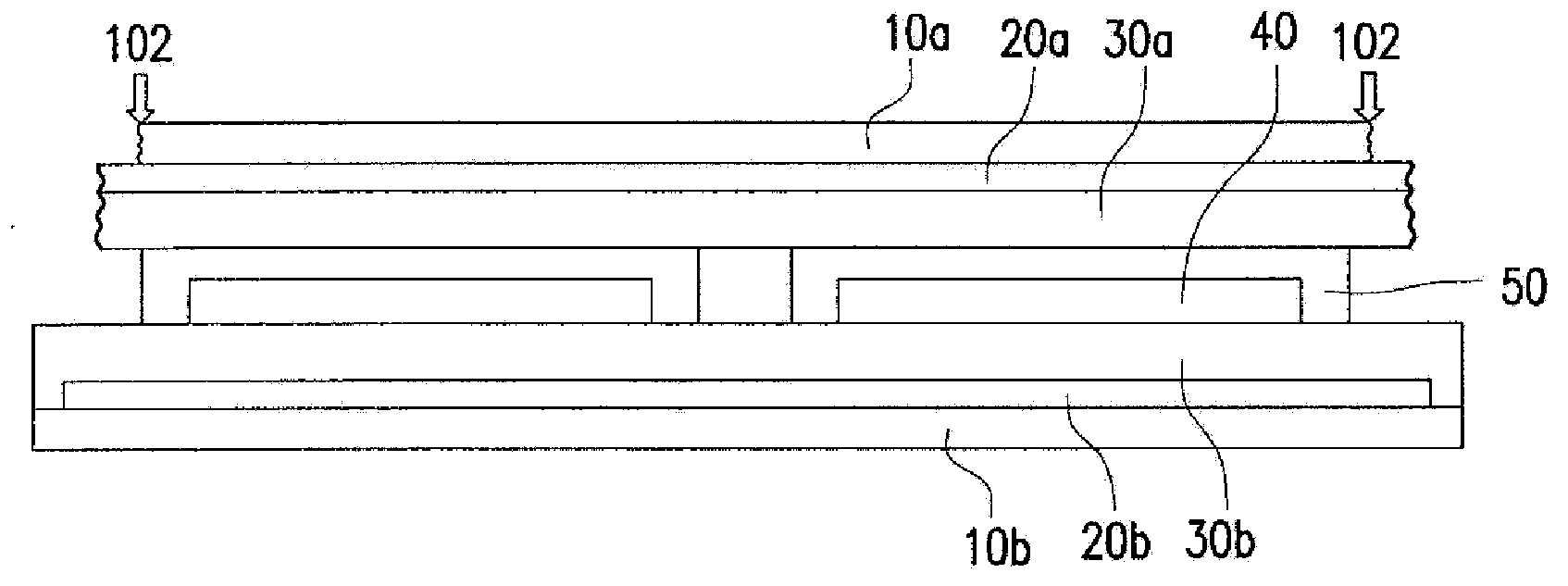Soft element taking-out method and substrates separating method
A separation method and a flexible technology, applied in the field of semiconductor technology, to overcome the low removal rate and difficulty in mass production, improve the back-end process, and overcome the problem of precise alignment of components
- Summary
- Abstract
- Description
- Claims
- Application Information
AI Technical Summary
Problems solved by technology
Method used
Image
Examples
no. 1 example
[0073] Figures 1A to 1F It is a schematic cross-sectional view of a method for taking out a flexible component according to the first embodiment of the present invention.
[0074] Please refer to Figure 1A , providing a first carrier 10a. The first release layer 20a and the first flexible substrate 30a are successively formed on the first surface 11a of the first carrier 10a, and all sides of the first release layer 20a and the first flexible substrate 30a have been formed at this moment. First pre-cut 100 . In one embodiment, the first flexible substrate 30a covers the first release layer 20a and the periphery of the first flexible substrate 30a is in contact with the first carrier 10a.
[0075] Please refer to Figure 1B , providing a second carrier 10b, a second release layer 20b, a second flexible substrate 30b and at least one flexible element 40 are sequentially formed on the first surface 11b of the second carrier 10b. In one embodiment, the second flexible substr...
no. 2 example
[0089] Figures 2A to 2G It is a schematic cross-sectional view of a method for taking out a flexible component according to the second embodiment of the present invention.
[0090] Please refer to Figure 2A , providing a first carrier 10c. A first release layer 20c and a first flexible substrate 30c are sequentially formed on the first surface 11c of the first carrier 10c. At this time, the first side (such as Figure 2A The first release layer 20c and the first flexible substrate 30c on the right side in ) have undergone first pre-cutting 200 . In one embodiment, the first flexible substrate 30c covers the first release layer 20c and the periphery of the first flexible substrate 30c is in contact with the first carrier 10c.
[0091] Please refer to Figure 2B , providing a second carrier 10d, a second release layer 20d, a second flexible substrate 30d and at least one flexible element 40 are sequentially formed on the first surface 11d of the second carrier 10d. In one...
no. 3 example
[0105] Figures 3A to 3C It is a schematic cross-sectional view of a method for taking out a flexible component according to a third embodiment of the present invention. The third embodiment is similar to the first embodiment, the difference is that the second flexible substrate 30b and the second carrier 10b of the first embodiment are separated by an existing method, while the first embodiment of the third embodiment The second flexible substrate 30b is separated from the second carrier 10b by the method of the present invention.
[0106] First, proceed Figure 1A to Figure 1E step, and then turn the whole group over so that it is upside down. In particular, in the step of providing the carrier 10b in the third embodiment, all sides of the second release layer 20b and the second flexible substrate 30b on the second carrier 10b have undergone second pre-cutting 300 (eg Figure 3A shown), but the first embodiment does not carry out the above-mentioned second pre-cutting st...
PUM
| Property | Measurement | Unit |
|---|---|---|
| Size | aaaaa | aaaaa |
Abstract
Description
Claims
Application Information
 Login to View More
Login to View More - R&D
- Intellectual Property
- Life Sciences
- Materials
- Tech Scout
- Unparalleled Data Quality
- Higher Quality Content
- 60% Fewer Hallucinations
Browse by: Latest US Patents, China's latest patents, Technical Efficacy Thesaurus, Application Domain, Technology Topic, Popular Technical Reports.
© 2025 PatSnap. All rights reserved.Legal|Privacy policy|Modern Slavery Act Transparency Statement|Sitemap|About US| Contact US: help@patsnap.com



